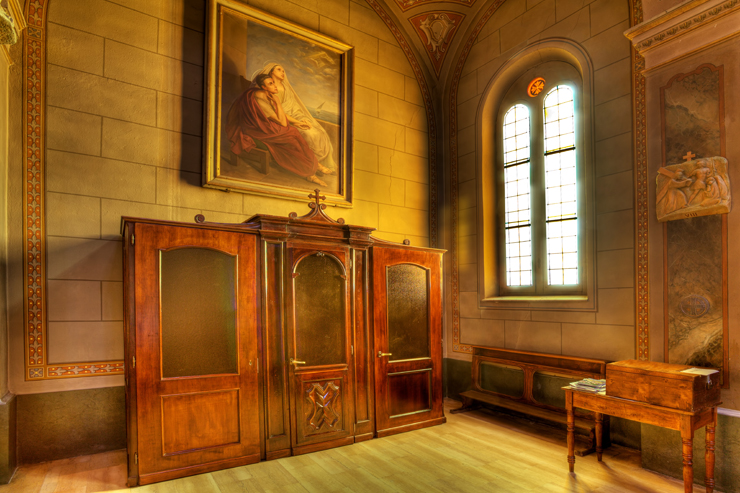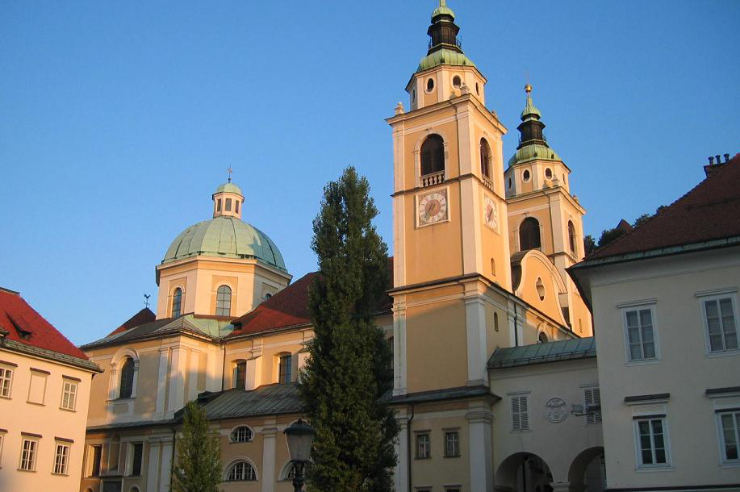Over the years, I have wondered how much Mary and I have in common. First I wondered, because I wasn’t a mother and we lived in such different times. Now I wonder, because I am not so patient or flawless in my mothering as I imagine she was. I asked myself if she could possibly understand the frustrations, the challenges, the difficulties I face monthly, daily, hourly. I pondered whether she actually looked, in real life, as pristine, as calm, as together, as she does in the various images of her.
I found my answer in Our Lady of Lourdes. No, this isn’t an apparition of Mary in an apron with her hair sticking up and grime staining her hands. It isn’t an apparition where the Blessed Mother admits that she was this close to just pulling the plug on the whole Mother of God gig. It isn’t affirmation for those who struggle with strong-willed children that they will ever be anything less than strong-willed.
At Lourdes, Mary appeared to a child, a child who was not very bright, according to her aunt, who was not very big, according to the fact that she was called by the diminutive form of her name, and not very remarkable, according to everyone who knew her. Marie-Bernarde Soubirous, called by the diminutive Bernadette because of her tiny stature, was the oldest of six children born to a poor miller in France. She was a weak and sickly child, prone to asthma and bouts of sickness. There were a few times, when work was scarce and food scarcer, that her parents sent her away to live with relatives so that she might be better off, and it was during the last of these that an aunt, upon trying to teach Bernadette about the Catholic faith, dubbed her thick-headed and gave it up as impossible and sent her home.
On the evening of February 11, 1858, 14-year-old Bernadette, her sister, Marie, and a neighbor, Jeanne Abadie, were gathering firewood. The two other girls crossed the canal and rubbed their feet after crossing at the cold. Bernadette hesitated, knowing the cold water could cause her asthma to flare up, and in that moment of hesitation, she heard a “great noise like the sound of a storm,” though there was no movement of trees or bushes. She heard the wind noise again, and noticed, at one of the openings of a nearby rock cleft, a single bush moving. Almost immediately, in that cleft, amidst the damp, dirt, and animal droppings, Bernadette saw a “golden colored cloud.”
She went closer, and it was there that she saw a beautiful young lady. Bernadette later described the lady—more appropriately called a girl—as “a tiny maiden” (un petito damizelo) of about sixteen or seventeen years, and she insisted that the maiden was no taller than herself. Bernadette was 1.4 meters (about 4 feet, 7 inches) tall, small even among the poorly nourished children of the time.
Bernadette said the lady wore a flowing white robe, a white veil on her head, a blue ribbon around her waist, a white rosary hanging from her right arm, and a yellow rose on each foot. This was nearly identical to the uniform of a religious group called the Children of Mary, apart from the yellow rose.
The lady was silent, but she signed to Bernadette, “as if She had been my Mother.” All fear left Bernadette, and she immediately took her rosary and got to her knees to begin praying. The lady prayed along, silent save for the Gloria at the end of each decade. At the end of the rosary, the lady returned to the cleft of the rock and disappeared.
The apparition appeared eighteen times to Bernadette in that filthy hidden grotto, the place called Massabieille or “Old Rock” by the locals. The grotto was known as the “pigs’ shelter” because the pigs feeding in the area usually took cover there. The contrast between the golden light and beautiful lady and her dark and dingy surroundings was distinct. We might find ourselves reminded of the Gospel message, where the immensity of goodness in God meets the smallness of poverty in the human person of Jesus. We can take from the setting of Lourdes—the obscurity of the town, the dirt of the grotto, the simplicity of the seer—that God will meet us where we are, right in the middle of our need and failings.
Though Bernadette tried to keep the vision a secret, she ended up explaining it to the other two girls when they returned to her. During their family prayer time that evening, she dissolved into tears, being very troubled about the apparition. When her mother asked her what was wrong, her sister answered and Bernadette ended up sharing the account of her experience. Her mother was very upset, calling the apparition an illusion and strictly forbidding Bernadette from returning to Massabieille.
Bernadette, however, could not believe that she had been deceived. She couldn’t get the image of the beautiful lady out of her mind, and she couldn’t believe that the devil could have tricked her—how, she wondered, could the devil carry a rosary and pray the Gloria?
Imagine the tension in the Soubirous house the next two days—teenage Bernadette not arguing (but not agreeing!) while mother Louise insisted the whole things was an illusion, a trick of the devil. Bernadette, for her part, pleaded to return to the rock cleft. I can hear the tone of voice she must have used, respectful but insistent. Louise ignored her for two days, but on Sunday, Bernadette could not ignore the internal summons she felt to return to the place. Knowing what her mother’s response would likely be, she confided in her sister, Marie, who tried to convince Louise to allow Bernadette to go. Louise remained resolute. Marie then went to the neighbor, Jean Abadie, who pleaded the case with Louise.
I picture Louise, after three days of arguing with teenage girls and one day of very gentle nagging, throwing up her hands and sighing heavily. Whatever her feelings on the matter, Louise had heard enough and she gave her permission. If it was an illusion, after all, they would see.
Louise reluctantly agreed for Bernadette to go a second, and then a third time, over the next few days. After the third appearance and the strange account of the lady finally speaking, telling Bernadette, “I do not promise to make you happy in this world, but in the next,” her parents were even more troubled. Who, exactly, was Bernadette rendezvousing with at Massabieille? Could it be…but no, surely their Bernadette—simple, ignorant, unschooled Bernadette, who hadn’t even made her First Communion yet, in part because she could not be taught the catechism—surely their Bernadette wasn’t meeting with the Mother of God!
Louise consulted with her wise sister Bernarde, who inserted practicality into the matter. “We ourselves have done wrong in not going to Massabieille with her to see what is really taking place there,” she said. She pointed out that if it was a heavenly inspired vision, there was nothing to fear, and if it was, on the other hand, a hoax of the devil, then not only would it prove to be so, but innocent Bernadette surely could not be deceived in her heart, protected as she must be by the very One they wondered if she was seeing. Seeing Bernadette in ecstasy was believing, and from that time, her parents or another adult accompanied her to the grotto for the visits.
It wasn’t until March 25, 1858, on the Feast of the Annunciation and during the sixteenth vision, that the lady finally consented to tell Bernadette her name. Bernadette, for her part, had given up finding out; she had asked persistently, on each visit, and she had made more visits to her priest with the lady’s request for a chapel. During that apparition, Bernadette felt compelled to ask, and so she did. She asked three times, and after the third time, the lady became very serious and seemed to bow down in an attitude of humility. Joining her hands under her breast, she looked up to heaven and declared, in the local dialect, “I am the Immaculate Conception” (Que soy era Immaculada Conceptiou).
Bernadette was smiling and quietly repeating some words to herself after the apparition ended, and some of her neighbors asked why she was so happy and what she was saying. She replied, “Oh, I’m repeating the name the lady has just this moment given me, for fear that I might forget it. She said to me, ‘I am the Immaculate Conception.’” She had to be corrected, because she was mispronouncing the word “conception.”
Though the priest did not admit it to Bernadette when she came to him with the lady’s name, confirming that it was, in fact, the Virgin Mary who was appearing in Lourdes, he said he was “so amazed by it that I felt myself stagger and I was on the verge of falling.” It could be no accident that only a couple of years before, in December of 1854, Pope Pius IX had declared, through the authority of the papal office, the dogma of Mary as the Immaculate Conception, conceived without sin. Though it had been celebrated since the Church’s very beginning, Pius IX declaring it as a dogma set it apart and made it unarguable. Mary declaring at Lourdes that she was the Immaculate Conception—surely a more difficult way to identify herself than “Mother of God” or “Blessed Virgin”—was clearly significant.
During the eighteen apparitions, Bernadette fell into ecstasy, which doesn’t do justice to the accounts of what happened when she was with Mary. At first, I pictured Bernadette unconscious, writhing, acting strangely. But what that phrase means, it seems, is that she was transformed from the simple, homely girl everyone knew into someone touched by true beauty. One writer of the time, who started as a cynic and cataloged everything very thoroughly, compared how Bernadette looked as opposed to how another girl, seeing a false apparition in the same spot, appeared. Bernadette, he said, was “transfigured,” and while she was in ecstasy, he felt “transported.” The other girl was simply “beautiful” and caused him to feel quite “surprised,” a marked difference.
The devil did attempt, through many different avenues, to discredit the Lourdes apparitions as they were happening. The police barricaded the grotto after the seventeenth apparition, and forbade anyone from visiting. In addition, quite a few children reported hearing terrifying voices and one child saw a woman who, though beautiful, seemed to have the “eyes of the devil.”
The difficulties did not keep the faithful away. During each apparition, Bernadette was steadfast in praying the rosary. Those who began to visit Lourdes followed her example. Mary, the Immaculate Conception, appeared to the most simple and humble of girls, one who trusted her completely. It’s a lesson we can all use and, for me, it begins in Bernadette’s persistence. She was discouraged and forbidden from pursuing the mysterious lady. Though her parents consented to go with her, and though they were eventually, without a doubt, believers, they must have never lost sight of the cost: of the unwanted fame—and visits—from thousands of pilgrims; of the ridicule from the newspapers; of the accusations of money-grubbing when they never accepted a cent, though they were in dire need. Bernadette never gave up, she never backed down, and she never failed in her humble pursuit of the beautiful lady, whom she knew had been sent from heaven. She didn’t let it go to her head, and she didn’t ever change her story, though she had plenty of opportunities. She didn’t give in to the fear of the threats, real and implied, of the authorities.
The miracles at Lourdes are well-documented. The water from the grotto, which flows from a spring Bernadette dug up at the Virgin’s request, a spring that never existed before, though proven to be chemically “normal,” is credited with healing. There are over seven thousand claimed miracles, of which sixty or so have been accepted as true miracles, with no other explanation from science or medicine. For me, though, those miracles aren’t what resound, they aren’t what draw me there, they aren’t what beckon me.
At Lourdes, Mary shows me that the imperfect can be made perfect. She also shows me that my own categorizing of perfect—including intellect, knowledge, comfort—is imperfect. Through Lourdes, I see a Mary who reminds me that, as I seek perfection, I sometimes lose sight of what my goal should be in my rush to achieve the ever-elusive prize of perfection. How often, in my quest for perfection, do I forget that the journey is as important—so often more important—than the prize? When have I worried about not having what I wants while not noticing that I have everything I need? And how often, in my hurry to reach perfection, have I failed to pause and enjoy the perfection God has sent me this day, hidden in the mud of everyday life?















